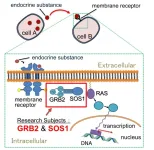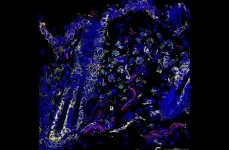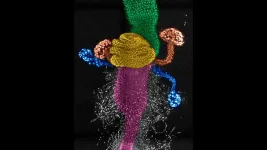Scientists uncover workings of “batons” in biomolecular relay inside cells
Workings of proteins GRB2 and SOS1 in signal transduction revealed using NMR
2024-10-26
(Press-News.org)
Tokyo, Japan – Researchers from Tokyo Metropolitan University have uncovered new insights into how the proteins GRB2 and SOS1 in cells pass signals from membrane receptors to nuclei. They used nuclear magnetic resonance (NMR) to study how and which specific regions of GRB2 and SOS1 bind to each other, especially how they trigger liquid-liquid phase separation (LLPS). Issues with signal transduction are a major cause of cancers: understanding how it works may lead to radical new treatments.
Biological cells work through an intricate network of signal pathways, where reactions in specific parts of the cell lead sequentially to others through structural changes in proteins, a vast biomolecular relay where “batons” are passed on through a cascade of proteins binding and modifying each other. This “signal transduction” procedure is key to the healthy function of cells; mutations in the genes encoding for these signal-passing proteins account for many tumors and cancers. In the search for new treatments and prevention methods, scientists have focused their efforts on understanding how the relay works, and how the whole process is regulated.
A team of researchers led by Associate Professor Teppei Ikeya from Tokyo Metropolitan University have been studying the role played by GRB2 and SOS1, two proteins known to play an important role in passing information from certain membrane receptors to the RAS protein, itself a key player in getting signals to the cell nucleus, where DNA resides. This eventually leads to the cell being able to use the original signal to regulate the production of more proteins. However, the exact workings of this pathway are not fully understood. A big reason for this was the softness, or “floppiness,” of GRB2 and SOS1, making them difficult to study with tools like X-ray crystallography and cryo-transmission electron microscopy.
Now, the team have used nuclear magnetic resonance (NMR) techniques and cutting-edge statistical tools to uncover new details about how GRB2 and SOS1 take part in signal transduction. GRB2 is known to have three domains (NSH3, SH2, CSH3), where the two SH3 domains (NSH3, CSH3) bind to the SOS1 protein. While it was long believed that they both bound with the same strength to SOS1, the team found that NSH3 had ten to twenty times more affinity for SOS1 than CSH3. Not only that, they also discovered key differences in their dynamics; CSH3 exhibited free mobility independent of the other domains..
The picture this yielded was far more detailed than anything previously imagined for RAS signal transduction. It also tied into recent research which suggests that GRB2 and SOS1 take part in liquid-liquid phase separation (LLPS), where they form dense droplets in cells and regulate how strongly signals are passed to RAS. In the team’s new mechanism, the parts of SOS1 sticky to the SH3 domains would be able to bind multiple NSH3 domains due to their strong affinity, while the flexible CSH3 domain can attract other free SOS1 molecules. This leads to the GRB1 protein acting like a bridge, leading to large, flexible domains rich in GRB2 and SOS1. This is the first time a mechanism has been proposed for LLPS of GRB2 and SOS1.
This unprecedented level of detail provides new insights into how cell signaling works and may help us understand how pathologies take root when it does not function as it should. The team hopes their findings will inspire not only new research, but routes to new cancer treatments.
This work was supported by the Funding Program for Core Research for Evolutional Science and Technology (CREST JPMJCR13M3 and JPMJCR21E5) from the Japan Science and Technology Agency (JST), Grants-in-Aid for Scientific Research (JP15K06979, JP19H05645) and Scientific Research on Innovative Areas (JP15H01645, JP16H00847, JP17H05887, JP19H05773, JP26102538, JP25120003, JP16H00779 and JP21K06114) from the Japan Society for the Promotion of Science (JSPS), the Shimadzu Foundation, and the Precise Measurement Technology Promotion Foundation. The NMR experiments were performed using the NMR Platform supported by the Ministry of Education, Culture, Sports, Science and Technology (MEXT), Program Grant Number JPMXS0450100021.
END
[Attachments] See images for this press release:

ELSE PRESS RELEASES FROM THIS DATE:
2024-10-26
San Diego, CA (October 25, 2024) — Glucagon-like peptide-1-receptor agonists (GLP-1RA) are medications that are increasingly prescribed for patients with type 2 diabetes and congestive heart failure. Reports of GLP-1RA–associated acute kidney injury (AKI) have emerged, but the risk of GLP-1RA–associated AKI among patients on anti-cancer drugs is unclear. Surprisingly, new research suggests that taking GLP-1RA is not associated with an increased risk of AKI in patients receiving anti-cancer therapies. The findings will be presented at ASN Kidney Week 2024 October 23– 27.
For the study, investigators analyzed ...
2024-10-26
San Diego, CA (October 25, 2024) — Prior efforts to identify novel kidney biomarkers as risk factors for chronic kidney disease (CKD) progression have typically evaluated proteins individually, which limits their prognostic power. The National Institute of Diabetes and Digestive and Kidney Diseases’ (NIDDK’s) CKD Biomarkers Consortium of investigators recently developed and tested novel dimensions of kidney health by combining a set of 17 urine and plasma biomarkers that ...
2024-10-26
San Diego, CA (October 25, 2024) — IgA nephropathy (IgAN) is an autoimmune kidney disease driven by immune cells that express a protein called CD38 on their surface. A recent Phase 2 trial revealed that felzartamab, an investigational anti-CD38 monoclonal antibody, helps to reduce proteinuria and maintain patients’ kidney function. Investigators evaluated the molecular mechanisms underlying felzartamab’s potential efficacy in IgAN. The findings will be presented at ASN Kidney Week 2024 October 23– 27.
It is hypothesized that CD38+ cells ...
2024-10-26
San Diego, CA (October 25, 2024) — Sodium-glucose co-transporter 2 (SGLT2) inhibitors reduce the risk of cardiovascular and kidney outcomes in patients with type 2 diabetes, but it is unclear whether their effects differ based on patients’ age. A recent analysis of clinical trial data reveals that the SGLT2 inhibitor canagliflozin benefited patients across all age categories. The findings will be presented at ASN Kidney Week 2024 October 23 – 27.
The analysis pooled individual participant data from the CANVAS Program and CREDENCE trial and assessed efficacy and safety according to baseline age. ...
2024-10-25
The Arctic is warming at three to four times the global average. However, new research suggests the slowing of a key ocean current could reduce projected Arctic warming by up to 2 degrees Celsius by the end of the century.
For years, scientists have warned that unchecked Arctic warming could lead to devastating consequences, threatening wildlife and ushering in an era of more frequent and extreme weather events. Amid concerns for these types of outcomes, a study led by UC Riverside offers some limited relief.
The study, published in the Proceedings of the National Academy of Sciences, examined ...
2024-10-25
San Diego, CA (October 25, 2024) — A recent analysis reveals that the number of chronic kidney disease (CKD) cases in women around the globe nearly tripled in the past three decades. Also, type 2 diabetes and hypertension were the leading causes of CKD-related deaths in women. The research will be presented at ASN Kidney Week 2024 October 23– 27.
The analysis drew from the Global Burden of Disease study 2021, a comprehensive effort to quantify health loss across the world over time. The study includes information from 204 countries and territories.
From 1990 to 2021, the average annual percentage ...
2024-10-25
Ever had an itchy nose or, worse, an unreachable spot on your back that drives you mad? Now imagine an itch that refuses to go away, no matter how hard or long you scratch. That persistent itch, or pruritus, may actually be one of the skin’s first lines of defense against harmful invaders, according to neuroimmunologist Juan Inclan-Rico of the University of Pennsylvania.
“It’s inconvenient, it’s annoying, but sensations like pain and itch are crucial. They’re ever-present, especially when it comes to skin infections,” says Inclan-Rico, a postdoctoral researcher in the Herbert Lab at ...
2024-10-25
It feels like narcissism is everywhere these days: politics, movies and TV, sports, social media. You might even see signs of it at work, where it can be particularly detrimental. Is it possible to keep a workplace free of destructive, manipulative egotists?
More and more organizations have come to San Francisco State University’s experts in organizational psychology asking for help doing just that. In response, University researchers developed a tool for job interviews to assess narcissistic grandiosity among potential job candidates. San Francisco State Psychology Professors Kevin Eschleman and Chris ...
2024-10-25
You have likely not spent much time thinking about the uterus of the fruit fly, Drosophila melanogaster. But then, neither have most scientists, even though Drosophila is one of the most thoroughly studied lab animals. Now a team of biologists at the University of California, Davis, has taken the first deep look at the Drosophila uterus and found some surprises, which could have implications not just for understanding insect reproduction and potentially, pest control, but also for understanding fertility in humans.
The work is published Oct. 25 in Proceedings of the National Academy of Sciences.
Drosophila have been a favorite subject for ...
2024-10-25
A recent commentary published in The Lancet journal highlights the critical importance of skeletal muscle mass in the context of medically induced weight loss, particularly with the widespread use of GLP-1 receptor agonists. These medications, celebrated for their effectiveness in treating obesity, have raised concerns regarding the potential for substantial muscle loss as part of the weight loss process.
Dr. Steven Heymsfield, professor of metabolism and body composition, and Dr. M. Cristina Gonzalez, adjunct and visiting professor in metabolism-body composition, both of Pennington Biomedical Research Center, joined colleagues Dr. Carla Prado of the University ...
LAST 30 PRESS RELEASES:
[Press-News.org] Scientists uncover workings of “batons” in biomolecular relay inside cells
Workings of proteins GRB2 and SOS1 in signal transduction revealed using NMR



